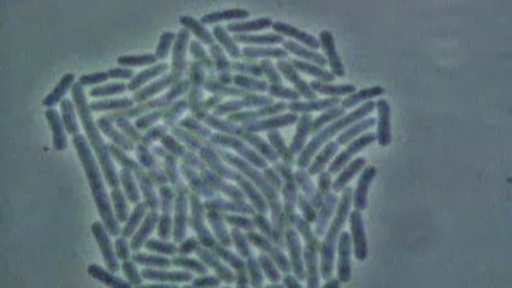1.1 Bacterial growth
Bacteria reproduce by a straightforward process in which each cell splits into two identical, new cells. This process is called
Individual bacterial cells can divide, and the bacterial population can double, very quickly – in as little as 20 minutes in some species. Watch the following video to see a speeded-up film of binary fission.

However, bacteria do not continue growing at such a rapid rate indefinitely. This is because factors such as the availability of nutrients and rising toxin levels start to have an effect. You can explore this in the first activity. Don’t worry if you don’t understand all the terms, as they will be explained later.
Activity 1 Bacterial growth phases
In nature, bacterial growth follows a typical pattern shown in Figure 1. The growth curve is comprised of four phases.
- Lag phase: during the lag phase, the bacteria are adapting to their environment; nutrients are plentiful and the cells grow in size without dividing. Cell number remains constant.
- Exponential phase: the exponential phase marks a big increase in cell number. Maximum growth rate is achieved with a constant doubling of the bacterial population. Growth then slows as nutrients become depleted and bacterial waste products build up to toxic levels.
- Stationary phase: the bacteria enter the stationary phase when the number of new cells equals the number of cells dying. The total number of cells in the population remains constant.
- Death phase: unless nutrients are replenished and waste products removed, the bacteria progress to the death phase. More cells die than are produced and the number of cells in the population declines.
(a) Using drag-and-drop, match the descriptions above to the correct phase of the growth curve. Don’t worry if you are not sure of the correct answer at this stage. You can check your answers by clicking on the buttons below Figure 1.
Answer
- During the lag phase, the bacteria are adapting to their environment; nutrients are plentiful and the cells grow in size.
- The exponential phase marks a big increase in cell number. Maximum growth rate is achieved with a constant doubling of the bacterial population. Growth then slows as nutrients become depleted and bacterial waste products build up to toxic levels.
- The bacteria enter the stationary phase when the number of new cells equals the number of cells dying.
- Unless nutrients are replenished and waste products removed, the bacteria progress to the death phase. More cells die than are produced and the population declines.
Because they can divide so rapidly, bacteria adapt quickly to changes in their surroundings. Advantageous characteristics which allow the bacteria to flourish in the new conditions are passed on to successive generations and the species evolves rapidly. In Week 4 you will learn about the genetic mechanisms underlying this process.
